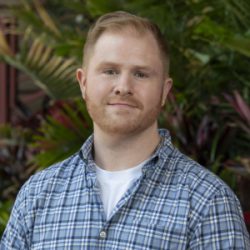Interests
My lab employs induced pluripotent stem cell (iPSC) neurons and glia derived from amyotrophic lateral sclerosis (ALS) patients to study the molecular pathogenesis of neurodegeneration and aging. Specifically, my lab wants to understand the subcellular processes involved in age-related and selective neurodegeneration observed in ALS. ALS is a fatal neurologic disease characterized by the progressive degeneration of motor neurons and interneurons in the brain and spinal cord. A unifying pathological feature of ALS is the cytoplasmic inclusion of nuclear proteins observed in post-mortem CNS tissue. Nuclear pore complexes (NPC) are channels that span the nuclear envelope and regulate the transport of proteins ≥40 kDa from passively entering or exiting the nucleus. NPC proteins are incredibly long-lived in post-mitotic cells and, consequently, NPC integrity is lost during normal aging thus resulting nuclear-cytoplasmic protein mislocalization. I have recently shown that a common ALS mutation, the C9ORF72 HRE, disrupts NPC function and nucleocytoplasmic trafficking. This impairs nuclear protein import and enhances cytoplasmic accumulation of predominantly nuclear proteins that are also shown to accumulate in the cytoplasm of neurons and glia of ALS patients. These are the first studies implicating NPC dysfunction in neurodegeneration and it is therefore enticing to postulate that NPC dysfunction or premature deterioration is a converging pathway in ALS pathogenesis. My lab utilizes iPSC models to study the mechanisms that underlie NPC and nucleocytoplasmic trafficking dysfunction in ALS and similar disorders that also exhibit aggregate pathology, including frontotemporal dementia (FTD) and traumatic brain injury. The goals of these studies are to uncover novel mechanisms that lead to selective neurodegeneration and to develop methods of intervention to prevent neural injury. Our long-term studies include: 1) in vivo validation of these mechanisms in existing neurodegenerative animal models and ALS patient tissue; 2) to identify intrinsic differences in the NPC composition of affected and unaffected neural subtypes in ALS; 3) develop models to link NPC/nucleocytoplasmic trafficking deficits to selective neurodegeneration; and 4) to rescue these trafficking defects and selective neurodegeneration in vivo with existing and novel therapeutics.
Training
| BS | Biological Sciences | Drexel University | 2005 |
| PhD | Molecular Biology and Genetics | University of Delaware | 2011 |
| Postdoctoral Fellowship | Neuroscience, ALS/FTD, Neurodegeneration, iPSC | Johns Hopkins University School of Medicine | 2015 |
Positions Held
| Postdoctoral Fellow | Johns Hopkins University School of Medicine | 2011-2015 |
| Assistant Professor of Neurobiology | University of Pittsburgh School of Medicine | 2015-present |
Honors and awards
2009 Delaware Chapter SfN Poster Symposium, First Place
Society for Neuroscience
2014 ADDF Outstanding Young Investigator Award
Alzheimer’s Drug Discovery Foundation
2014 FENS Forum Travel Award
Society for Neuroscience and the
Federation of European Neurosciences Societies
Selected Publications
S. Li, J.J. Overman, D. Katsman, C.J. Donnelly, J.L. Twiss, G. Coppola, D.H. Geschwind, S.T. Carmichael (2010) An age-related sprouting transcritome provides molecular control of axonal sprouting after stroke. Nature Neuroscience 13(12): 1496-1504.
D.E. Willis,* M. Xu,* C.J. Donnelly,* C. Tep, M. Kendall, M. Erenstheyn, A. English, N.C. Schanen, C.B. Kirn-Safran, S.O. Yoon, G.J. Bassell, J.L. Twiss (2011) Axonal Localization of transgene mRNA in mature PNS and CNS neurons. The Journal of Neuroscience 31(41): 14481-14487.
(*authors share equal contribution)
C.J. Donnelly,* D.E. Willis*, M. Xu*, C. Tep, M. Kendall, M. Erenstheyn, A. English, N.C. Schanen, C. Kirn-Safran, S.O. Yoon, G. Bassell, J.L. Twiss (2011) Limited availability of ZBP1 restricts axonal mRNA localization and nerve regeneration capacity. EMBO 30 (22): 4665-4677.
(*authors share equal contribution)
M. Spillane, M. Ketschek, C.J. Donnelly, J.L. Twiss, G. Gallo (2012) Nerve growth factor-induced formation of axonal filopodia and collateral branches involves the intra-axonal synthesis of regulators of the actin nucleating Arp 2/3 complex. The Journal of Neuroscience 33 (8): 3311-3322.
C.J. Donnelly, M. Park, M. Spillane, S. Yoo, A. Pacheco, C. Gomes, D. Vuppalanchi, M. McDonald, H.K. Kim, T.Merianda, G. Gallo, J.L. Twiss (2013) Axonally synthesized -actin and GAP-43 proteins support distinct modes of axonal growth. Journal of Neuroscience 33 (8): 3311-3322.
C.J. Donnelly, P.W. Zhang, J.T. Pham, A.R. Haeusler, N.A. Mistry, S. Vidensky, E.L. Daley, E.M. Poth, B.N. Hoover, D.M. Fines, N. Maragakis, P.J. Tienari, L. Petrucelli, B.J. Traynor, J. Wang, F. Rigo, C.F Bennett, S. Blackshaw, R. Sattler, J.D. Rothstein (2013) RNA toxicity from the ALS/FTD C9ORF72 expansion is mitigated by antisense intervention. Neuron 80 (2): 415-428.
A.M. Haidet-Phillips, L. Roybon, Li Y, C.J. Donnelly, C.E. Henderson, N.J. Maragakis. (2013). Gene profiling of human iPSC-derived astrocyte progenitors following spinal cord engraftment. Stem Cell Translational Medicine. 3 (5): 575-585.
A.R. Haeusler, C.J. Donnelly, G. Periz, R. Sattler, E. A. Simko, P.G. Shaw, M. S. Kim, A. Pandry, J.D. Rothstein, J. Wang. (2013). Structural polymorphisms of C9ORF72 hexanucleotide repeats cause ALS/FTD defects through abortive transcription and nucleolar stress. Nature 507 (7491): 195-200.
Zhang,* C.J. Donnelly,* A.R. Haeusler, J. C. Grima, J.B. Machamer, E.L. Daley, S. Vidensky, M.A. Thomas, K.M. Cunningham, P. Steinwald, M.J. Matunis, J. Wang, R. Sattler, T.E. Lloyd, J.D. Rothstein. (2015). The C9ORF72 repeat expansion disrupts nucleocytoplasmic transport. Nature (IN PRESS)
(*authors share equal contribution)
